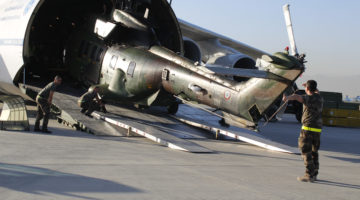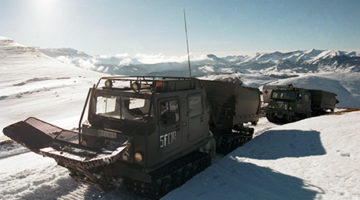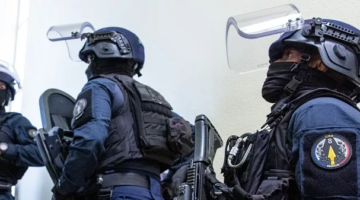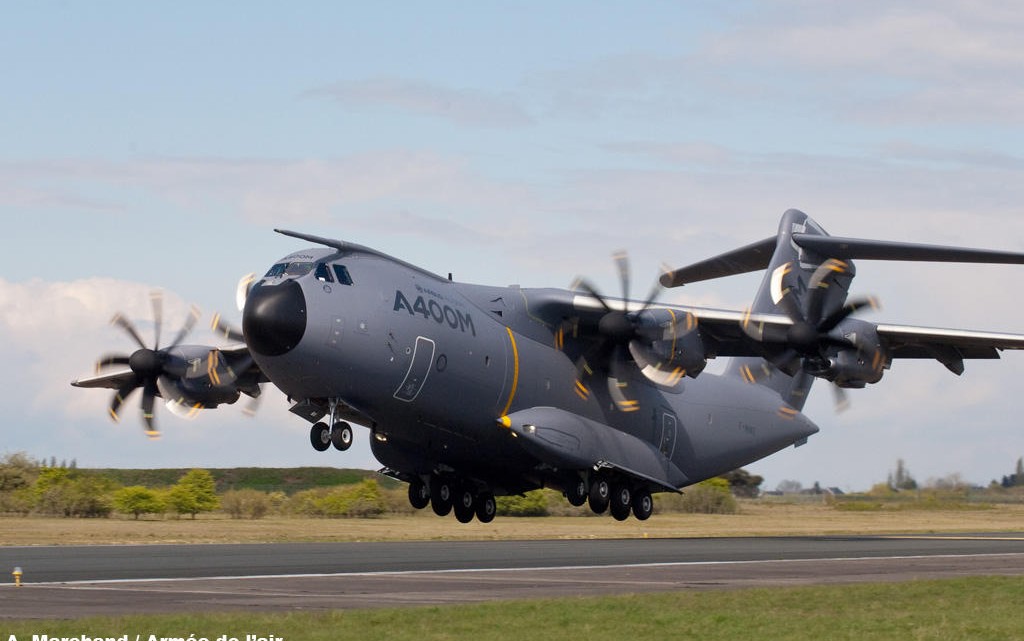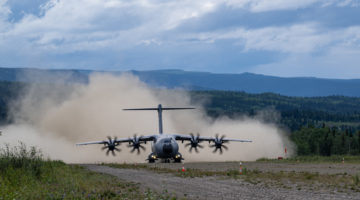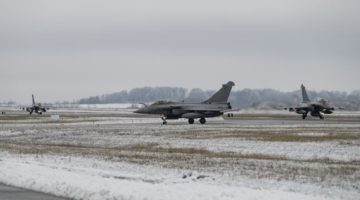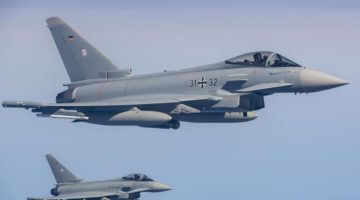Crédits photos © Ministère de la Défense
ILA Berlin Air Show 2014: Airbus Defence and Space to present a broad portfolio
>> Abstract from : www.airbus-group.com >>
- The recently integrated Division will demonstrate technological highlights in the fields of defence and space in the Airbus pavilion at the Berlin ExpoCenter Airport
- Press Briefing of Airbus Defence and Space on 20 May 2014, 2:30pm, in hall 3, Press Centre
From 20 to 25 May 2014, Airbus Defence and Space will present its broad portfolio in the Airbus pavilion at the international aerospace exhibition ILA Berlin 2014. As one of the three Divisions of the Airbus Group, Airbus Defence and Space generates revenues of approximately €14 billion per year and is Europe’s number one defence and space enterprise, the second largest space business worldwide and among the top ten global defence enterprises.
Airbus Defence and Space will present the A400M on the ground and in the air. The A400M is a newly developed military transport aircraft specially designed to meet the requirements of armed forces in the 21st century. With its high-performance turboprop propulsion units, the A400M flies higher, faster and further. At the same time, it has excellent manoeuvrability and low-speed flight capabilities, as well as the ability to operate on short and unsurfacedrunways. Equipped with state-of-the-art technologies, the A400M is not just suited to tactical and strategic/logistical missions, but also for special operations such as air-to-air refuelling. With its specially designed cargo hold, the A400M is also able to quickly bring bulky equipment, which is becoming increasingly important for military and humanitarian aid missions, to where it is most urgently needed. In August 2013, the first A400M, delivered to the French Air Force, went into service. There are currently around 35 aircraft in various stages of production, including six out of a total of 53 A400Ms for the German Armed Forces.
The newest Eurofighter exhibition model will also be displayed at the Airbus pavilion. The Eurofighter is the most modern and capable multi-role combat aircraft currently on the market. Currently, seven nations (Germany, the UK, Italy, Spain, Austria, Saudi Arabia and Oman) have procured the Eurofighter. To date, the Eurofighter fleet has completed more than 200,000 flight hours world-wide, thus making the aircraft the safest and one of the most reliable combat aircraft in operation. With 719 aircraft under contract, 571 orders and over 400 deliveries, theEurofighter is currently the largest military procurement programme in Europe and, thanks to its advanced technology, strengthens the European aviation industry’s position in international competition. The programmemeans work for more than 100,000 people at 400 companies.
Airbus Defence and Space will also display Unmanned Aerial Vehicles (UAVs) at the ILA 2014 The Heron 1 is a Medium Altitude Long Endurance (MALE) Unmanned Aerial Vehicle (UAV) System operated by the German Air Force. Based on the IAI (Israel Aeronautic Industries) Heron platform – it is a combat proven system in the MALE category of UAVs and is dedicated to reconnaissance and tracking operations in the depth of the battlefield. A tactical fixed wing reconnaissance Unmanned Aerial Vehicle (UAV) System designed and launched by Airbus Defence and Space, the TR-50 Scout is designed to perform military missions including intelligence, reconnaissance, surveillance and target acquisition. With over 30 flights completed since its initial flight in 2010, the TR-50 Scout accomplished its first final configuration flight in December 2013. The system is now being demonstrated to partners and customers.
The KZO is a combat proven tactical fixed wing reconnaissance Unmanned Aerial Vehicle (UAV) System designed and launched by Airbus Defence and Space to perform military missions including high-precise reconnaissance targeting and damage assessment. With 12 systems and 60 UAVs delivered, the KZO is in service with the German Army since 2005, and successfully accomplished over 1,000 missions supporting ISAF operations in Afghanistan since 2009. Airbus Defence and Space’s leading role in driving the development of unmanned flight technologies is also underlined by the technology demonstrator “Sagitta”. The Sagitta research programme represents an innovative airframe concept which is used by Airbus Defence and Space and collaborating industry and up to 15 university partners across Germany to develop intelligent solutions in core technology areas such as stealth Unmanned Aerial Vehicle Systems (UAS), autonomous flight and data transmission.
Further exhibition highlights will include the Ariane 5 Midlife Evolution (ME) launcher, which Airbus Defence and Space is continuing to develop for the European Space Agency (ESA). Planned for a first flight mid 2018, the Ariane 5 Midlife Evolution (ME) launcher will be capable of placing up to 12 metric tons of payload in geostationary orbit, with two satellites of over five tons being launched in a single flight.
The power and supply unit MPCV-ESM (Multi-purpose Crew Vehicle – European Service Module) currently being developed by Airbus Defence and Space for the American “Orion” capsule is one of the highlights in the 1,500 m² space hall, which Airbus Defence and Space is hosting as a key partner together with the ESA, the Federal Ministry of Economics and Energy (BMWi), the German Aerospace Center (DLR) and the German Aerospace Industries Association (BDLI). This module is based on the design and the experiences of the automated transfer vehicle (ATV) supply craft developed and constructed by Airbus Defence and Space for the international space station. The European service module MPCV-ESM is a cylinder with a height and a diameter of around four metres, and will be attached below the Orion space capsule. In addition to its propulsion function for the Orion spacecraft, the MPCV-ESM will, when it is docked with the crew module, be responsible for orbital manoeuvres and attitude control, providing water and oxygen for the crew, providing power and controlling the temperature.
The space spectrometer NIRSpec (near-infrared spectrograph), which Airbus Defence and Space delivered to NASA to be integrated into the James Webb Space Telescope (JWST), will also be on display in the space hall. As a central instrument of the Hubble successor, the “super eye” will in future be able to simultaneously detect up to one hundred celestial bodies such as galaxies and stars, thereby enabling scientists to observe large parts of space on an unprecedented scale and look back into the past.
Another highlight of the exhibition is Gaia, Europe’s most advanced space telescope, which Airbus Defence and Space has built for the ESA. It currently provides a high-precision 3D map of our galaxy and the Milky Way and can detect previously undiscovered objects. The aim of the mission is to give us deeper insights into the origins and development of our galaxy. It is estimated that hundreds of thousands of new celestial bodies will be discovered, and tens of thousands of asteroids will be identified.
With an interactive presentation from WorldDEM, Airbus Defence and Space will present a digital elevation model (DEM) that recently entered the market and covers the Earth from pole to pole with unprecedented accuracy.WorldDEM will improve the quality of DEM applications for customers in numerous industries such as defence, aviation, oil and gas extraction or mining. The new model is based on the data from the high-resolution German radar satellites TerraSAR-X and TanDEM-X that were developed in a public-private partnership (PPP) between the DLR and Airbus Defence and Space with funds from the BMWi. While the data from the Shuttle Radar Topography Mission (SRTM) previously offered a raster width of 90 metres, WorldDEM covers the entire world with a raster width of just 12 metres. WorldDEM guarantees a standardised, worldwide DHM. The offset-free coverage beyond regional and country borders offers defence customers a whole new level of precision for military aviation, mission planning and operations anywhere in the world. In civil aviation, numerous flight systems will also profit from more precise input data.
*** Posted by Quentin Michaud


